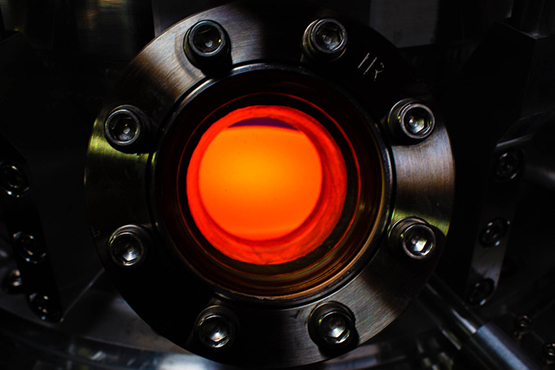In 1947, a small but mighty slogan changed the very fabric of society, and forever changed the way the world looked at diamonds. Engineered by the DeBeers corporation, “A diamond is forever” wriggled the small gemstone permanently into the lives of almost every couple.
Yet, it is astonishing to believe that a small, highly structured, seemingly innocent bundle of carbon has historically started wars, bankrupted companies, and spawned an economic trade filled with bloodshed and death. Like most tightly controlled industries, the diamond industry has been long overdue for a disruption. And in usual fashion, mainstream society didn’t really start to fuss until the release of “Blood Diamond”, starring Leonardo DiCaprio and Djimon Hounsou, brought to light (at least fictionally) the problems with blood diamonds.
Photo Credit: Diamond Foundry
Therefore, when the news caught wind that DiCaprio had invested in an emerging man-made diamond company, people began to consider the diamond industry as one open to change. This groundbreaking company, “Diamond Foundry”, is poised to disrupt the diamond industry by producing diamonds in a lab. I had the pleasure of speaking to R. Martin Roscheisen, the founder of the company, and one of the leaders bravely changing the way a diamond is produced and cherished.
Roscheisen is no stranger to disruption. Co-founder of FindLaw, Nanosolar, and other industry changing companies, Roscheisen has been a Silicon Valley staple since the late 1990s. After making his way into the solar energy industry, he launched Diamond Foundry in 2015 to provide an alternative source to what he saw as an unethical and environmentally damaging product.
At times brusque and other times passionate, Roscheisen answered my questions with the same attitude a professor would answer lecture questions: clear, to the point, and with no nonsense. Simply put, diamonds should be seen no more as a commodity and just a good in need of better controls, ethics, and overall renewed perception. Strip a diamond of its cloying marketing and you are left with just a gemstone.
Related article: “THE HUMAN EXPERIENCE THROUGH ALUMINUM“
Diamond Foundry’s page has a pithy statement: “Diamonds. Evolved.” Evolution is exactly what this company is seeking to do. A founding team of M.I.T., Stanford, and Princeton engineers came together in San Francisco, CA to figure out how to grow a diamond in a lab rather than in the earth’s core. Using technology originally pioneered by General Electric, the diamonds are created atom by atom with “Atomic Layer Deposition” technology. It’s a process that creates high temperature plasma to simulate the high temperatures found deep in the Earth to “grow” a diamond in the lab.
The entire man-made diamond process takes about two weeks to complete and utilizes a reactor composed of 350 individually precision-engineered parts that were designed based on tens of thousands of software simulations. The science behind this was only discovered three years ago and Diamond Foundry has been perfecting it ever since.
What makes these diamonds so innovative and groundbreaking is that there is no carbon footprint. In fact, the company proudly touts “Zero questions around origin. Zero middleman  markups. Zero carbon footprint.” Roscheisen, when asked about what drives him to continue his work with Diamond Foundry, “We’re at the very beginning of creating a more sustainable and honest industry.”
markups. Zero carbon footprint.” Roscheisen, when asked about what drives him to continue his work with Diamond Foundry, “We’re at the very beginning of creating a more sustainable and honest industry.”
The Kimberley Process was specifically created by the United Nations to curtail corruption, the financing of wars, and overall bloodshed associated with the diamond trade in South Africa. With little to no real ability to ensure compliance, the process has been generally deemed unsuccessful. Therefore, Diamond Foundry is the perfect way to drive down the demand for mined diamonds by providing a better and more ethical source.
In the Photo (above): The company’s foundry. Photo Credit: Diamond Foundry
Roscheisen stated, “Mining has an environmental and social imprint unlike any other human activity. It happens at a vast, inhuman industrial scale. There is nothing romantic about mining. There’s 3 million slaves digging for diamonds in Africa; and in India, the small diamonds are polished “up in the villages”, a euphemism for child labor. De Beers just recently killed 18,405 fish by draining an entire lake in Canada to access the area for diamond exploitation.”
He also very clearly pointed out that Diamond Foundry’s business model also includes little to no supply chain since it only buys water and carbon dioxide. Because every diamond is made in the lab, the company knows every origin of every atom of a diamond. No chance for corruption, pollution, or unethical price markups. And there is currently plenty of corruption in the traditional diamond business.
Of course, the pull of a “real”, mined diamond and overall jewelry store marketing is strong. A big misconception is that lab made diamonds are more similar to cubic zirconia. However, these diamonds are as real as one pulled out of the earth with no synthetic quality, something even Neil deGrasse Tyson was able to prove. Half of the battle for Diamond Foundry and Roscheisen is educating customers. “It’s like asking someone in 1990 whether they would buy an electric car, at a time when the only electric cars in existence are golf carts. Once customers see our diamonds in a store and understand their cultivation, there is zero resistance.”
Even with the allure of ethical practices, zero carbon footprint, and quality of product, Diamond Foundry is fighting generations of societal perception. Lab made diamonds still cost a lot to produce and there’s a strong need to stay competitive with other more traditional jewelry companies. But without a middle man and therefore no markups, the diamonds are sourced straight from the foundry and therefore can come at a lower price for customers.
Roscheisen admitted that the main demographic the company is aiming for is millennials. They are the generation most likely to choose a diamond based on ethical and environmental reasons when looking for where to buy an engagement ring, while not caring about its lab origins. The company also recently acquired Vrai & Oro, a direct-to-customer jewelry brand, to produce designer engagement rings using Diamond Foundry diamonds. If you are looking for the best engagement rings, you can visit Gema & CO to know more about different engagement ring options.
In the Photo: A selection of engagement rings. Photo Credit: Diamond Foundry
Even though the diamond industry has seen slowing global sales and limited market growth, it’s here for the foreseeable future. Whether or not someone is in the market to buy a ring for that special someone now or in the future, the future of diamonds is evolving from the traditional brick and mortar stores with inflated prices and questionable ethical standards to a new business model that values the product just as much as we value the person wearing it. And when that next proposal comes along, you can truly and wholeheartedly say, “yes”.
Recommended reading: “THE BURMESE RUBY- IT’S A CONFLICT STONE ALRIGHT“












